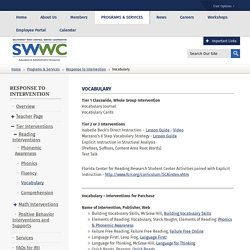

No Tears for Tiers: The CCSS Tiered Vocabulary Made Simple. The Common Core State Standards place an importance on academic vocabulary.
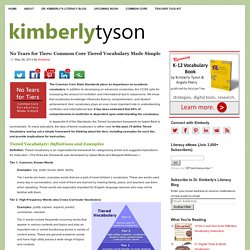
In addition to developing an advanced vocabulary, the CCSS calls for increasing the amount of nonfiction and informational text in classrooms. We know that vocabulary knowledge influences fluency, comprehension, and student achievement. And, vocabulary plays an even more important role in understanding nonfiction and informational text. It has been estimated that 80% of comprehension in nonfiction is dependent upon understanding the vocabulary. In Appendix A of the Standards, the Tiered Vocabulary framework by Isabel Beck is summarized.
Tiered Vocabulary: Definitions and Examples Definition: Tiered Vocabulary is an organizational framework for categorizing words and suggests implications for instruction. Tier 1: Common, Known Words Examples: big, small, house, table, family Tier I words are basic, everyday words that are a part of most children’s vocabulary. Tier 3: Low-Frequency, Domain-Specific words 1. 2. 3. 21 Digital Tools to Build Vocabulary. If you follow this blog, you know that I believe effective vocabulary instruction is just about the most important instructional activity for teachers to get right. For lots of reasons. Vocabulary influences fluency, comprehension, and student achievement. How’s that for starters? In addition, a broad vocabulary is important for effective speaking, listening, reading and writing. Vocabulary is a foundational component of an effective K-12 comprehensive literacy framework.
I write frequently about the importance of effective vocabulary instruction and my recent infographic – the 10 Do’s and Don’ts of Effective Vocabulary Instruction – has proved very popular having been Pinned over 31,000 times. In today’s 21st century classrooms, digital tools must coexist alongside more traditional tools. Digital tools have advantages. The following digital tools show promise to support word learning, review, and playing with language. 8 Strategies for Teaching Academic Language. "Change your language and you change your thoughts.
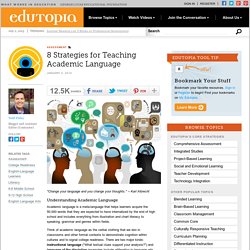
" -- Karl Albrecht Understanding Academic Language Academic language is a meta-language that helps learners acquire the 50,000 words that they are expected to have internalized by the end of high school and includes everything from illustration and chart literacy to speaking, grammar and genres within fields. Think of academic language as the verbal clothing that we don in classrooms and other formal contexts to demonstrate cognition within cultures and to signal college readiness.
There are two major kinds: instructional language ("What textual clues support your analysis? ") and language of the discipline (examples include alliteration in language arts, axioms in math, class struggle in social studies and atoms in science). Where to Start It would be a mistake to think that academic language is a garbage pail category involving any word, depending on the context.
Teaching Academic Language 8 Specific Strategies. Common Core / CCSS Mathematics Vocabulary Cards for All Grade Levels. Literature Based Word Lists. VocabularySpellingCity provides a wide range of literature-based vocabulary word lists to support your students in their reading comprehension and vocabulary acquisition.
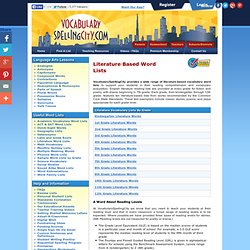
English literature reading lists are provided at every grade for fiction and poetry, with drama beginning in 7th grade. Each grade, from kindergarten through 12th grade, features ten literature-based lists from works recommended by the Common Core State Standards. These text exemplars include classic stories, poems, and plays appropriate for each grade level. A Word About Reading Levels At VocabularySpellingCity we know that you need to teach your students at their reading level and that in every classroom a broad range of reading levels is to be expected. The Grade Level Equivalent (GLE) is based on the median scores of students in a particular year and month of school. Choosing Literature for Your Students Ready-Made Word Lists You can use VocabularySpellingCity literature lists in different ways.
{12 Days: Tool 10} Infographic: Top 10 Characteristics of Effective Vocabulary Instruction. We know that there is a strong relationship between vocabulary and reading comprehension.
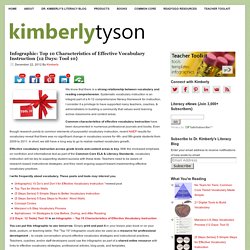
Systematic vocabulary instruction is an integral part of a K-12 comprehensive literacy framework for instruction. I consider it a privilege to have supported many teachers, coaches, & administrators in building a community that values word learning across classrooms and content areas. Vocab Interventions for RTI Tiers 1 2 3 .pdf. Designing RTI-Based Vocabulary Interventions. Smart Speech Therapy LLC is celebrating #BHSM2015 ASHA Better Hearing and Speech Month.

So without further ado, below you will find my recommendations for designing effective vocabulary interventions for struggling students. This past academic year I have been delivering vocabulary intervention once a week for an hour in my setting to 5 different classrooms of low achieving students. This allowed me to research quite a bit regarding the principles of vocabulary teaching as well as gave me an opportunity to adapt and design my own vocabulary intervention materials. Vocabulary is of course one of the integral components of reading comprehension along with phonological awareness, phonics, and reading fluency. Response to Intervention / Vocabulary. Tier 1 Classwide, Whole Group Intervention.
